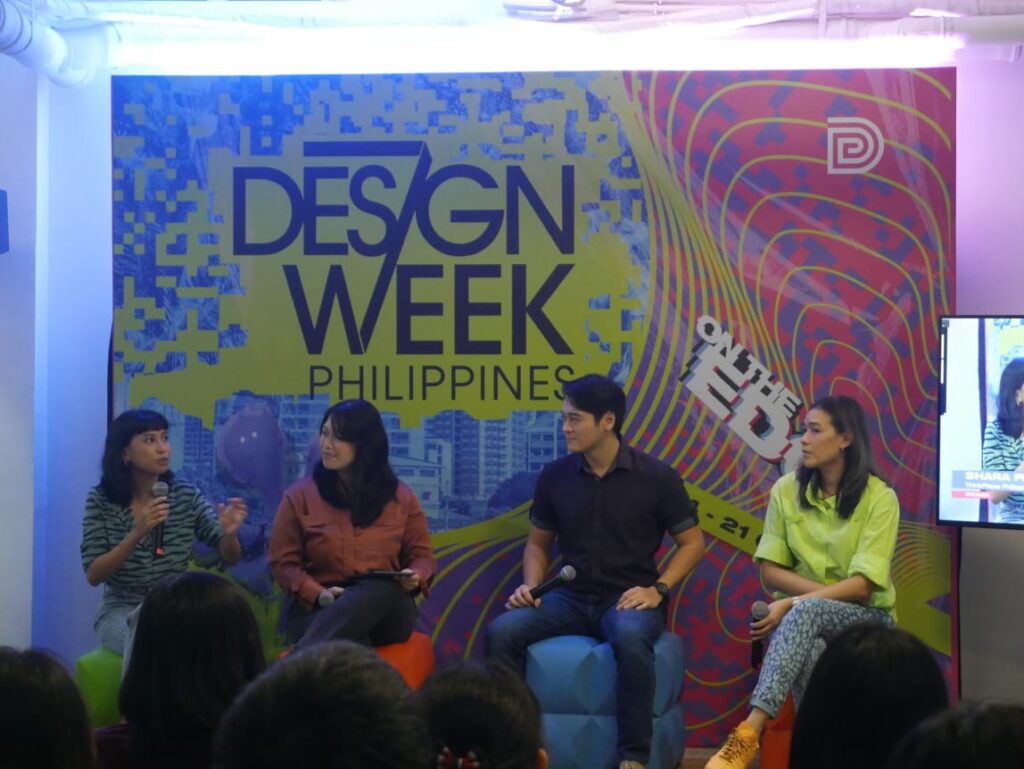For the past few years since the Design Center of the Philippines was created in 1973 through Presidential Decree 279, this attached agency of the Department of Trade and Industry has been going beyond promoting the value of good design. Its mission statement now includes “inspiring and equipping creative industries to create human-centered products, services and spaces that enable inclusive and sustainable economic growth.”

These creative industries are not confined to traditional handicrafts, but also comprise the technologically inclined, such as graphic design and user experience design. They were discussed at the 12th edition of the agency’s annual initiative, Design Week Philippines, which ran from 14 to 21 October with simultaneous events in several cities across the nation.
On the opening day of Design Week Philippines: On the Edge held at independent culture hub The Astbury in Makati City, designers Shara Francisco, Maine Manalansan, Aldrich Tan and Liliana Manahan led the talk titled “Designing Your Career.” It was meant for those who wish to work in graphic design, user experience design and other related fields. The panelists later participated in reviewing the portfolios of industry upstarts.
Graphic design
“Gathering all these creatives and having this big event is very important to the industry,” said Jowee Alviar, co-founder and creative director of TeamManila graphic design studio. He spoke to DAILY TRIBUNE during a break in folio reviews.
“Maybe to network and collaborate, get to know the other players. For young practitioners, makita nila (they’ll see) that the government understands what they’re doing. Kasi (Because) it’s a young industry with lots of players.”
Alviar hoped that more parents would let their children get into graphic design, which is defined by the online Encyclopedia Britannica as “the art and profession of selecting and arranging visual elements — such as typography, images, symbols and colors — to convey a message to an audience.”
He explained that a lot of people still don’t believe there’s money to be made in the arts, and that’s what he and his colleagues try to debunk. “We need more champions like Kenneth Cobonpue and younger artists doing well in pursuing their passion. Para makita ng parents na successful sila sa art. (So parents can see their children can be successful in art).”
He then pointed out, “If you’re a designer, hindi mo kailangang mag-ibang bansa para kumita ng (you don’t need to work abroad to earn) dollars. Marami ngayon na ang client nila sa ibang bansa (There are now many overseas clients), online. Kumikita ka ng (You earn in) dollars, ‘tapos nakaka-travel ka pa kasi wala kang office (then you get to travel because you’re not office-bound).
“Minsan, hindi nakikita ang gano’ng klaseng work (Sometimes such work is overlooked). Freelance work is usually under the radar. Hindi lang naiintindihan ng (It’s not understood by) parents. As creatives, kailangan nating ipaintindi (we need to make people understand it.)
Alviar added, “I think one of the challenges for us designers is to engage more clients. If you use design as a strategy, magi-increase pa talaga ang growth ng company mo (your company’s growth will increase) — revenue, brand equity. May ibang companies na hindi pa nila nare-realize ang (There are companies that still don’t realize the) potential ng design, like better packaging, logo, website, branding.”
UX design
Aldrich Tan also shared his experiences and expertise at the Design Week activities, first as a designer who started in graphics and now into user experience, or UX. It is defined by The Interaction Design Foundation as “the process design teams use to create products that provide meaningful and relevant experiences to users.” You usually find this in general websites and specialized e-commerce.
“I realized UX is the link for the business to prosper,” he pointed out as the co-founder and chief experience officer of NextPay, which offers financial services to entrepreneurs in various industries. “If you have a bad website, people will judge na parang sketchy business ito.”
He lamented that UX design is “often overlooked,” thus explaining, “People think design is just graphics. But now we’re realizing it’s so much more, even customer service. You can design the experience of your customer service. It’s very broad.”
Tan, who’s also the managing director of the nonprofit organization UXPH, has these pieces of advice to young practitioners and career shifters to UX design: “Start learning and researching as early as possible. Just look online for courses. There are so many resources online available for free. Don’t give up right away. Just try again and again and again until you find what you love or what you’re really good at.
“That’s why we’re also doing the portfolio reviews to learn how to talk about themselves more, present yourself apart from the job market. In a number of years, it’s going to be more and more integrated. My hope is that college, or even high school, students can learn about it because it has a lot of potential to help our country and society.”
